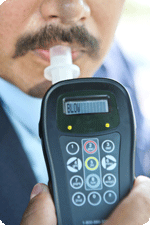Sober to Start
Make our roads and country safer.
States requiring ignition interlock devices for first time offenders have shown a decrease in deaths caused by drunk driving. Contribute today!
The average drunk driver has driven drunk 80 times before a first arrest, and on any given day, your family shares the roadways with more than 2 million drunk drivers who have had three or more prior convictions.
While suspending the license of these individuals makes sense, in reality, three out of four of those with a suspended license continue to drive, threatening the safety of you and your loved ones. That’s why MADD supports the usage of ignition interlock devices to require all convicted drunk drivers to prove they are sober before the car will start.
What is an Ignition Interlock?

An ignition interlock is a device about the size of a cell phone that is wired into the ignition system of a vehicle. A convicted drunk driver must blow into the device in order to start their vehicle. If they have a measurable amount of alcohol in their system, the vehicle will not start. It is a simple and economical way to make sure that offenders can drive to and from work, but that they can’t drive drunk.
Requiring Interlocks for All Offenders Saves Lives
West Virgina, Arizona, Louisiana and New Mexico have all seen their drunk driving deaths drop dramatically after all-offender interlock laws were passed. CDC research finds reductions in repeat offenses of about two-thirds due to interlocks.
Just think, if about a third of the drunk driving problem that kills almost 11,000 people each year and injures about 315,000 more comes from repeat offenders, and we can reduce their repeat offenses by two-thirds, we can save thousands of lives and prevent tens of thousands of injuries each year.
Now it’s not that simple, for a few reasons:
- Currently, 37 states, plus Washington D.C., require interlocks for all offenders. See if your state is one here. If it isn’t, we need you to let your legislators know you want this law passed.
- Even when laws are passed, they are not always enforced. We need court monitors to help see if the system is failing us; please click here to volunteer with MADD.
2017 Ignition Interlock Report
2016 Ignition Interlock Report
2021 Ignition Interlock Report
What Can You Do to Help?
We need your help to require use of this life-saving technology by all offenders. Ask your representatives to require interlocks for all offenders.
Make our roads and country safer.
States requiring ignition interlock devices for first time offenders have shown a decrease in deaths caused by drunk driving. Contribute today!
Today, we can see a future without drunk driving, but we need your help to get there. Please join us in the fight by pledging to support the future of No More Victims®.
Fields marked with an * are required
"*" indicates required fields
†MADD may provide periodic automated text messages and calls to your mobile number. SMS, Msg & Data rates may apply. Text STOP to cancel or HELP for help.
Ignition Interlock FAQs
No. MADD advocates requiring ignition interlocks only for convicted drunk drivers with an illegal blood alcohol concentration of .08 or greater.
Alcohol ignition interlocks are required to meet standards set by the National Highway Traffic Safety Administration (NHTSA). These standards ensure that the devices are reliable.
Offenders pay for the interlocks, as they are the ones getting the benefit from it (the ability to drive legally).
On average, interlocks are about $70-150 to install and about $60-80 per month for monitoring and calibration. This is less than three dollars a day. In most states, interlock companies provide interlock devices for offenders who can’t afford the devices or an indigent fund is set up by the state to cover costs for these offenders.
This is possible, and there should be strict penalties for blowing into someone else’s ignition interlock or for having someone else blow into the device. However, interlocks are required to have anti-circumvention features that prevent such activity. One of these features is the running retest, which requires offenders to blow into the device at random intervals once the vehicle has been allowed to start. Furthermore, blowing into an interlock is a learned skill that requires specific training that would most likely be difficult for an impaired person to administer. There are also tamper-proof seals on interlocks.
This is possible. However, when someone commits a crime, he/she is responsible for the consequences of his/her actions. If an interlock is one of these consequences, then the offender is responsible for making sure those driving his/her vehicle do not drive intoxicated. State laws should also have provisions for an appeals process in which offenders can appeal failed tests.
No, the devices have temperature and air gauges to make sure this cannot occur.
Studies have shown that interlock devices decrease recidivism by about two-thirds while installed on the vehicle. When removed, these rates tend to go back to normal. This might not be the case if interlock programs were coupled with treatment and offenders were not allowed to have the device removed until they demonstrated a period of compliance. The possibility of re-offending is much greater if tests are failed during the interlock period. Unfortunately in most states, offenders still automatically get the device removed at the end of the specified period, even if they failed a test the day before. To make laws more effective, states should add provisions for treatment and extended periods for non-compliance.
Interlocks are hooked up to a vehicle’s starter system, not to the engine itself. The interlock does not have the ability to stop the vehicle once it is running for safety reasons. When a driver fails a running retest, the vehicle’s horn will honk and/or the lights will flash to alert law enforcement – the vehicle will not stop.
The tests are not designed to be done while the car is actually rolling. Interlocks give people a few minutes – enough time to pull over – to perform the retest.
Courts throughout the states have analyzed this issue and no state appellate court has overturned an interlock statute.
No, they can drive the vehicle as well; they simply must blow into the device and prove sobriety before the car will start. Having an interlock installed on an offender’s vehicle actually allows the offender and his or her family to continue to drive legally. Other sanctions like vehicle impoundment or immobilization do not allow for this.
Individuals with low lung capacities due to being ill, having asthma or pulmonary disorders are generally able to provide the needed breath sample. If they can demonstrate that they are unable, the device settings can be adjusted to account for this. Failing that, medical waivers are needed.
They can and do. It is imperative that state laws plan for this by requiring that all cars that the offender operates, not just owns, are equipped with an interlock. Also, offenders choosing not to drive should be required to have some other form of electronic monitoring, like continuous alcohol-sensing ankle bracelets. In Hancock County, Indiana, alcohol ignition interlock installation rates increased from 20 percent to 62 percent when the alternative was electronic monitoring. These policies alone reduced DWI/DUI rates by 40 percent for first offenders and 22 percent for repeat offenders.
Some judges do not know how they work or do not understand their effectiveness. Judicial education on this topic is so important because generally those judges who know the most about interlocks are the ones using them most.
Why? The illegal drunk driving limit in all 50 states and Washington, D.C. is .08 BAC. Studies show that offenders with extremely high-BACs are only slightly more likely than offenders just over the legal limit to recommit the crime of drunk driving.




